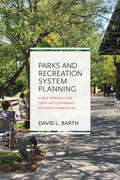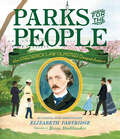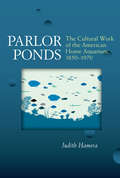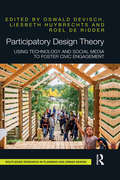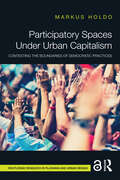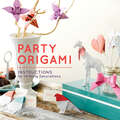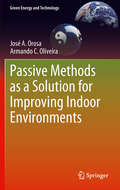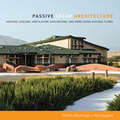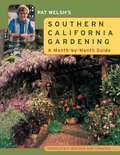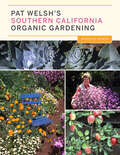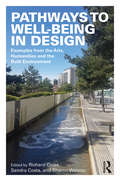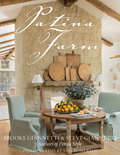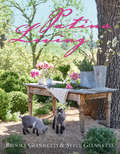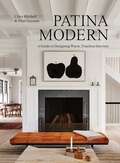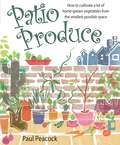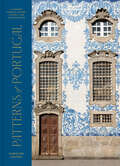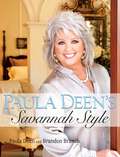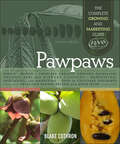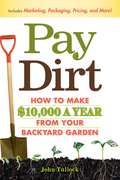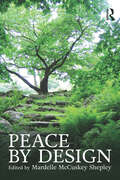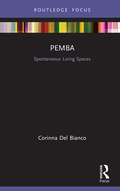- Table View
- List View
Parks and Recreation System Planning: A New Approach for Creating Sustainable, Resilient Communities
by David BarthParks and recreation systems have evolved in remarkable ways over the past two decades. No longer just playgrounds and ballfields, parks and open spaces have become recognized as essential green infrastructure with the potential to contribute to community resiliency and sustainability. To capitalize on this potential, the parks and recreation system planning process must evolve as well. In Parks and Recreation System Planning, David Barth provides a new, step-by-step approach to creating parks systems that generate greater economic, social, and environmental benefits.Barth first advocates that parks and recreation systems should no longer be regarded as isolated facilities, but as elements of an integrated public realm. Each space should be designed to generate multiple community benefits. Next, he presents a new approach for parks and recreation planning that is integrated into community-wide issues. Chapters outline each step—evaluating existing systems, implementing a carefully crafted plan, and more—necessary for creating a successful, adaptable system. Throughout the book, he describes initiatives that are creating more resilient, sustainable, and engaging parks and recreation facilities, drawing from his experience consulting in more than 100 communities across the U.S.Parks and Recreation System Planning meets the critical need to provide an up-to-date, comprehensive approach for planning parks and recreation systems across the country. This is essential reading for every parks and recreation professional, design professional, and public official who wants their community to thrive.
Parks for the People: How Frederick Law Olmsted Designed America
by Elizabeth PartridgeNational Book Award finalist Elizabeth Partridge reveals the life and work of Frederick Law Olmsted, the designer of Central Park, the United States Capitol building's landscape, and more.Nobody could get Frederick Law Olmsted to sit still. He was filled with energy, adventure, and dreams of changing the world. As a boy, he found refuge in the peace and calm of nature, and later as an adult, he dreamed of designing and creating access to parks for a growing and changing America. When New York City held a contest for the best park design for what would become Central Park, Olmsted won and became the father of landscape architecture. He went on to design parks across America, including Yosemite National Park and even the grounds for the United States Capitol.This scenic biography is lavishly illustrated by Becca Stadtlander, and National Book Award finalist Elizabeth Partridge brings her renowned lyricism and meticulous research to the visionary who brought parks to the people.
Parlor Ponds: The Cultural Work of the American Home Aquarium, 1850-1970
by Judith HameraParlor Ponds: The Cultural Work of the American Home Aquarium, 1850–1970examines the myriad cultural meanings of the American home aquarium during the nineteenth and twentieth centuries and argues that the home aquarium provided its enthusiasts with a potent tool for managing the challenges of historical change, from urbanization to globalization. The tank could be a window to an alien world, a theater for domestic melodrama, or a vehicle in a fantastical undersea journey. Its residents were seen as inscrutable and wholly disposable “its,” as deeply loved and charismatic individuals, and as alter egos by aquarists themselves. Parlor Pondsfills a gap in the growing field of animal studies by showing that the tank is an emblematic product of modernity, one using elements of exploration, technology, science, and a commitment to rigorous observation to contain anxieties spawned by industrialization, urbanization, changing gender roles, and imperial entanglements. Judith Hamera engages advertisements, images, memoirs, public aquarium programs, and enthusiast publications to show how the history of the aquarium illuminates complex cultural attitudes toward nature and domestication, science and religion, gender and alterity, and national conquest and environmental stewardship with an emphasis on the ways it illuminates American public discourse on colonial and postcolonial expansion.
Participatory Design Theory: Using Technology and Social Media to Foster Civic Engagement
by Oswald Devisch Liesbeth Huybrechts Roel De RidderIn recent years, many countries all over Europe have witnessed a demand for a more direct form of democracy, ranging from improved clarity of information to being directly involved in decision-making procedures. Increasingly, governments are putting citizen participation at the centre of their policy objectives, striving for more transparency, to engage and empower local individuals and communities to collaborate on public projects and to encourage self-organization. This book explores the role of participatory design in keeping these participatory processes public. It addresses four specific lines of enquiry: how can the use and/or development of technologies and social media help to diversify, to coproduce, to interrupt and to document democratic design experiments? Aimed at researchers and academics in the fields of urban planning and participatory design, this book includes contributions from a range of experts across Europe including the UK, Belgium, the Netherlands, Italy, Denmark, Austria, Spain, France, Romania, Hungary and Finland.
Participatory Spaces Under Urban Capitalism: Contesting the Boundaries of Democratic Practices (Routledge Research In Planning And Urban Design Ser.)
by Markus HoldoCan people use new participatory spaces to reclaim their rights as citizens and challenge structures of political power? This book carefully examines the constraints and possibilities for participatory governance under capitalism. To understand what is at stake in the politics of participation, we need to look beyond the values commonly associated with it. Citizens face a dilemma: should they participate, even if this helps to sustain an unjust system, or not participate, thereby turning down rare opportunities to make a difference? By examining the rationale behind democratic innovation and the reasons people have for getting involved, this book provides a theory of how citizens can use new democratic spaces to challenge political boundaries. Connecting numerous international case studies and presenting original research from Rosario, Argentina, this book offers a crucial corrective to previous research. What matters most is not the design of new models of participation nor is it the supposed radical imagination of political leaders. It is whether people use new spaces for participation to renegotiate what democracy means in practice. Bridging critical urban studies and democratic theory, this book will be of interest to researchers and students in the fields of democratic innovations, political economy and urban planning. It will also provide activists and practitioners of participatory democracy with important tools to expand spaces of grassroots democracy.
Party Origami: Instructions for 14 Party Decorations
by Jessica OkuiTransform beautiful origami paper into covetable party accents! With a booklet featuring step-by-step folding diagrams, eye-catching party props are just a few folds away. Origami enthusiasts and fans of pretty paper accents will enjoy folding chopstick rests, napkin rings, place settings, invitations, and more, in a range of colors and patterns.
Passive Methods as a Solution for Improving Indoor Environments
by José A. Orosa Armando C. OliveiraThere are many aspects to consider when evaluating or improving an indoor environment; thermal comfort, energy saving, preservation of materials, hygiene and health are all key aspects which can be improved by passive methods of environmental control. Passive Methods as a Solution for Improving Indoor Environments endeavours to fill the lack of analysis in this area by using over ten years of research to illustrate the effects of methods such as thermal inertia and permeable coverings; for example, the use of permeable coverings is a well known passive method, but its effects and ways to improve indoor environments have been rarely analyzed. Passive Methods as a Solution for Improving Indoor Environments includes both software simulations and laboratory and field studies. Through these, the main parameters that characterize the behavior of internal coverings are defined. Furthermore, a new procedure is explained in depth which can be used to identify the real expected effects of permeable coverings such as energy conservation and local thermal comfort as well as their working periods in controlling indoor environments. This theoretical base is built on by considering future research work including patents and construction indications which will improve indoor environmental conditions with evidence from real data. This makes Passive Methods as a Solution for Improving Indoor Environments an ideal resource for specialists and researchers focusing on indoor air quality, thermal comfort, and energy saving or with a general interest in controlling indoor environments with passive methods.
Passive Solar Architecture
by David A. Bainbridge Ken HaggardThis pocket reference book provides a wealth of practical information at your fingertips, whenever you need it. Rich in background detail, at-a-glance tables and diagrams, equations, and more, the Passive Solar Architecture Pocket Referenceis a handy resource for architects, engineers and students. Coverage includes: Definitions Load determinants and Responses (including world wide biomes and climates, building metabolism and response, thermal sources and sinks, passive building responses to sources and sinks, tuning the building to the environment, optimizing insulation & thermal mass for comfort) Contextual Aspects (including microclimate and siting, temperatures, humidity, wind, radiation and comfort parameters) Passive Components (including building envelope, passive solar terminology, orientation, apertures and glazing, thermal storage, thermal control and materials Design Tools (including sun path diagrams, sun peg diagrams, air flow relationships, thermal modelling and life cycle design) Specific Functions (including passive heating, passive cooling and ventilation, natural lighting, passive water heating, resource collection and Integrated design)
Pat Welsh's Southern California Gardening
by Pat WelshFirst published in 1992, Pat Welsh's Southern California Gardening sold well over 40,000 copies and received great critical acclaim. The completely revised and updated edition includes 40 new color photographs plus new information on perennials, ornamental grasses, geraniums, and more. Monthly chapters discuss relevant gardening topicsclimate, plant selection, soils, fertilizers, and wateringand are accompanied by handy checklists to help gardeners stay organized. An assortment of sidebars and rules of thumb will prove useful to gardeners in any region. Beautifully photographed and written in Pat Welsh's warm and practical style, this is an indispensable guide for every southern California gardener.
Pat Welsh's Southern California Organic Gardening: Month by Month
by Pat Welsh“Here is the southern California gardener’s calendar laid out with clarity and zest; no weasel words, no ifs and buts.” —Pacific HorticultureIn this completely revised and updated classic, beloved garden expert Pat Welsh shares how to garden the organic way. This edition includes forty color photographs; a simple month-by-month format that shows gardeners exactly what to do throughout the year; terrific advice on gardening with drought-tolerant and fire-resistant plants; and plenty of fresh information on organic soils, fertilizers, and pest control. Useful for newbies and seasoned green thumbs alike, Pat Welsh’s Southern California Organic Gardening is the indispensable guide for every Southern California gardener.
Pathways to Well-Being in Design: Examples from the Arts, Humanities and the Built Environment
by Richard Coles Sandra Costa Sharon WatsonHow can we achieve and promote well-being? Drawing on examples from the arts, humanities and design, this book brings together work from a wide range of areas to reveal the unique ways in which different disciplines approach the universal goal of supporting well-being. Pathways to Well-Being in Design recognises that the distinction between academics and practitioners often becomes blurred, where, when working together, a fusion of thoughts and ideas takes place and provides a powerful platform for dialogue. Providing new insights into the approaches and issues associated with promoting well-being, the book's multi-disciplinary coverage invites readers to consider these ideas within the framework of their own work. The book's 12 chapters are authored by academics who are involved in practice or are working with practitioners and features real world case studies which cover a range of situations, circumstances, environments, and social groups. Pathways to Well-Being in Design responds to those wishing to enquire further about well-being, taking the reader through different circumstances to consider approaches, discussing practice and theory, real world and virtual world considerations. This book is essential reading for anyone seeking to understand well-being, including students and professionals in architecture, landscape architecture, urban planning, design and health sciences.
Patina Farm
by Brooke Giannetti Steve GiannettiThe husband and wife team behind Giannetti Home welcome readers into their gorgeous farm residence blending modern style with French antiques. When Brooke and Steve Giannetti decided to leave their suburban Santa Monica home to build a new life on a farm, they traveled to Belgium and France for design inspiration. In Patina Farm they share their collaborative process, as well as the enviable result of their team effort and creativity: an idyllic farm in California&’s Ojai Valley. With two hundred gorgeous photographs and Steve&’s architectural drawings, Brooke takes readers through their inspirations, thought process, and materials selections. Readers are given a full tour of the family home, guesthouse, lush gardens, and delightful animal quarters.
Patina Living
by Brooke Giannetti Steve GiannettiThe husband and wife design team takes readers on a guided tour of their elegant farm residence in Ojai, CA—a home full of Patina Style inspiration. Brooke and Steve Gianetti offer an intimate look at their life on Patina Farm, the home they designed with an interplay of rustic and modern European charm. Beyond the gorgeously appointed farmhouse, the Giannettis readers through the sheds, outbuildings and gardens where they entertain and enjoy their miniature goats, sheep and donkeys, the chickens and ducks, and dogs. The entire residence is brimming with inspiration for a beautiful life in the popular Patina Style. &“We decided to write this book to share why we decided to create this life and what we have learned along the way. We share how we decided where to live, how to design and lay out our property and how to think about the individual spaces. One of the main nuggets of wisdom that we have learned is that there is not only one way to live this life. The idea of this book is to give you some options.&”
Patina Modern: A Guide to Designing Warm, Timeless Interiors
by Chris Mitchell Pilar GuzmánNamed one of Elle Decor&’s Best Coffee Table Books to Gift in 2022A tastemaking couple shares their playbook for creating a home that&’s both beautiful and comfortable Chris Mitchell and Pilar Guzmán are design obsessives who both want the same thing: rooms that are spare yet warm, layered yet clean, current yet timeless. Rooms that never forget the real humans—with all their needs, hopes, emotions, aspirations, and even spills—who live in these spaces. Over the course of six ever more ambitious home renovations, they&’ve cracked the code on how to achieve this. It&’s a simple formula, one that lies in mixing modern design with timeworn materials—in particular, white oak, brass, and bridle leather, all three of which become richer, mellower, and burnished with patina as they age. Add a few essential lessons (Decorating by Mood, Borrowing from the Best) and a nine-point manifesto that covers everything from lighting (rooms should feel like lanterns at night), to the use of black as an accent, to the intention that every space should serve multiple purposes, and the result is Patina Modern, a uniquely inspiring and practical design guide. The book leads by example, as the authors reveal in room-by-room detail the full evolution of their homes, including a Brooklyn brownstone and two classic Hamptons &“cottages.&” Along the way, we come to not only understand just how they see and think but also learn what they&’ve learned, getting an education in color, proportion, paint, and the world of modern furniture design, for which the authors have a special passion. Tools, principles, and the power of designing around the things you love—this is the gift of Patina Modern, showing just how to put it all together to create your own beautiful spaces.
Patio Produce: How To Cultivate A Lot Of Home-grown Vegetables From The Smallest Possible Space
by Paul PeacockHow to cultivate a lot of home-grown vegetables from the smallest possible space. When space is at a premium, growing decent food to eat might seem an impossible task. Patio Produce is about just that; growing delicious, wholesome fruit and vegetables in the smallest spaces. It shows you how to make the most of pots and planters; how to create decorative but edible displays; how to plan for a reasonable yield; and how never to run out of at least something special to eat. If you have a balcony on a high rise, a roof garden or a patio, you can immeasurably enhance your quality of life, maintain your health and enjoy some amazing meals from the freshest and richest ingredients. Patio Produce goes from plant pot to plate. Think quality, freshness, flavour and put these thoughts into your ever greening fingers. Inside there are detailed step-by-step instructions how to grow on the patio - not just for novelty's sake, but for flavour and an enhanced eating experience. You might not have all the space in the world, but you can enjoy all the flavour in the world. To know you have grown, nurtured, harvested and cooked to perfection your own vegetables and fruit, will make this book into an old friend.Contents: Preface; Chapter 1: The Environment of the Patio; Chapter 2: Planning for Crops All the Year Round; Chapter 3: Plants Grow Differently in Pots; Chapter 4: The Patio Gardener's Year; Chapter 5; How to Grow Vegetables on the Patio; Chapter 6: How to Grow Fruit on the Patio; Chapter 7: How to Grow Herbs on the Patio; Chapter 8: Varieties of Fruit and Vegetables; Index
Patio Produce: How to Cultivate a Lot of Home-grown Vegetables from the Smallest Possible Space
by Paul PeacockHow to cultivate a lot of home-grown vegetables from the smallest possible space. When space is at a premium, growing decent food to eat might seem an impossible task. Patio Produce is about just that; growing delicious, wholesome fruit and vegetables in the smallest spaces. It shows you how to make the most of pots and planters; how to create decorative but edible displays; how to plan for a reasonable yield; and how never to run out of at least something special to eat. If you have a balcony on a high rise, a roof garden or a patio, you can immeasurably enhance your quality of life, maintain your health and enjoy some amazing meals from the freshest and richest ingredients. Patio Produce goes from plant pot to plate. Think quality, freshness, flavour and put these thoughts into your ever greening fingers. Inside there are detailed step-by-step instructions how to grow on the patio - not just for novelty's sake, but for flavour and an enhanced eating experience. You might not have all the space in the world, but you can enjoy all the flavour in the world. To know you have grown, nurtured, harvested and cooked to perfection your own vegetables and fruit, will make this book into an old friend.
Patterns of Portugal: A Journey Through Colors, History, Tiles, and Architecture
by Christine ChitnisA vibrant tour of Portugal, featuring more than 200 photographs that bring to life one of the most beautiful countries in the world.In this gorgeous book, writer and photographer Christine Chitnis invites you to celebrate the unique, timeless beauty of Portugal through the stunning designs and hues that define Portugal&’s countryside, coast, small towns, and cosmopolitan cities.This collection features over 200 stunning photographs that illustrate the ways that color and pattern are woven into the very fabric of the country&’s culture, history, architecture, and traditions. Each section features insightful essays that explore the artistry of azulejos, the colorful ceramic tiles covering much of Portugal's architecture; the intricately embroidered details of traditional lavradeira costumes; the rich flavors of Portuguese cuisine, and so much more.Throughout these vibrant pages, you&’ll discover the vivid stories behind each color and pattern, transporting you to the gorgeous fields of Alentejo, the sparkling waters of the Algarve, the busy streets of Lisbon, the lush valleys of the Douro, and beyond.
Paula Deen's Savannah Style
by Paula DeenWith its lush gardens, stately town houses, and sprawling plantations, Savannah is the epitome of old Southern style, and who better to give you the grand tour than Paula Deen, the city’s most famous resident and anointed Queen of Southern Cuisine? In this gorgeous, richly illustrated book, Paula Deen shares a full year of Southern living. Whether it’s time to put out your best china and make a real fuss, or you’re just gathering for some sweet tea on the porch at dusk, Savannah style is about making folks feel welcome in your home. With the help of decorator and stylist Brandon Branch, you’ll learn how to bring a bit of Southern charm into homes from Minnesota to Mississippi. For each season, there are tips on decorating and entertaining. In the spring, you’ll learn how to make the most of your outdoor spaces, spruce up your porch, and make your garden inviting. In the summer, things get more casual with a dock party. Sleeping spaces, including, of course, the sleeping porch, are the focal point of this chapter. In the fall, cooler weather brings a return to more formal entertaining in the dining room, and in the winter, attention returns to the hearth, as Paula and her neighbors put out their best silver and show you how they celebrate the holidays. Paula loves getting a peek at her neighbors’ parlors, so she’s included photographs of some of Savannah’s grandest homes. From the vast grounds of Lebanon Plantation to the whimsically restored cottages on Tybee Island, you’ll see the unique blend of old-world elegance and laid-back hospitality that charmed Paula the moment she arrived from Albany, Georgia, with nothing but two hundred dollars and a pair of mouths to feed. And she isn’t shy about giving you a window into her own world, either. From her farmhouse kitchen to her luxurious powder room, you’ll see how Paula lives when she’s not in front of the camera. Packed with advice and nostalgia, Paula Deen’s Savannah Style makes it easy to bring gracious Southern living to homes north and south of the Mason-Dixon Line.
Pawpaws: The Complete Growing and Marketing Guide
by Blake Cothron“With this valuable book, you can pawpaw your own food forests, restoring the diversity, abundance, and climate we all need.” —Albert Bates, permaculture instructor, ecovillage designer, author of The Biochar SolutionPawpaws is the first in-depth guide to small-scale commercial cultivation of pawpaws. Also known as Indiana bananas or hipster bananas, this almost forgotten fruit, native to North America, is making a huge comeback with foodies, chefs, craft brewers, and discerning fruit-lovers.Written by, and for, the organic grower, coverage includes:Botany and the cultural history of pawpawsOrchard siting and planningChoosing the best-quality nursery treesDescriptions of over fifty cultivarsPropagation and organic growing tipsPests and disease managementMarketing and selling fresh pawpaws, seeds, and startsProcessing and producing value-added products.Get ahead of the farming curve, diversify your orchard or food forest, and discover the commercial potential of America’s almost forgotten native fruit with this comprehensive manual to small-scale commercial pawpaw production.“Blake Cothron is an authority on pawpaws and provides a clear, detailed guide for commercial success in growing this ‘oddly appealing species’ (his own words). The supply of this exotic, trending, easy-to-grow fruit has not yet met the demand. Blake shares the wealth of his knowledge, including challenges—and when he doesn’t know, he says so (it’s probable that others don’t know either).” —Pam Dawling, author of Sustainable Market Farming“The pawpaw’s revival is long overdue. Blake Cothron’s Pawpaws will help bring about the day when fragrant fruit is no longer a rare treat, but a regular part of our seasonal diet.” —Darrell E. Frey, Three Sisters Farm, author of Bioshelter Market Garden
Pay Dirt
by John TullockThere's gold to be dug in backyard gardens! But to turn dirt into dough, amateur farmers need some business tips. In the face of rising food prices and food poisoning scares, people want locally grown food, giving small gardeners the chance to turn a profit--ahealthy, green(not to mention good-for-you) profit. In this practical, step-by-step guide, you will learn how to: Sell overstock to local restaurants Participate in farmer's markets Grow cut flowers to sell Package your produce attractively Keep honey bees, chickens, and other alternative produce Packed full of gardening, marketing, and selling tips and tricks, this book shows you how to develop your own small plots of land (less than an acre) into a money-making resource. A good garden is full of greenbacks!
Pay Dirt
by John TullockThere's gold to be dug in backyard gardens! But to turn dirt into dough, amateur farmers need some business tips. In the face of rising food prices and food poisoning scares, people want locally grown food, giving small gardeners the chance to turn a profit--a healthy, green (not to mention good-for-you) profit. In this practical, step-by-step guide, you will learn how to: Sell overstock to local restaurants Participate in farmer's markets Grow cut flowers to sell Package your produce attractively Keep honey bees, chickens, and other alternative produce Packed full of gardening, marketing, and selling tips and tricks, this book shows you how to develop your own small plots of land (less than an acre) into a money-making resource. A good garden is full of greenbacks!
Pay Dirt: How To Make $10,000 a Year From Your Backyard Garden
by John TullockThere's gold to be dug in backyard gardens! But to turn dirt into dough, amateur farmers need some business tips. In the face of rising food prices and food poisoning scares, people want locally grown food, giving small gardeners the chance to turn a profit-a healthy, green (not to mention good-for-you) profit. In this practical, step-by-step guide, you will learn how to:Sell overstock to local restaurantsParticipate in farmer's marketsGrow cut flowers to sellPackage your produce attractivelyKeep honey bees, chickens, and other alternative produce Packed full of gardening, marketing, and selling tips and tricks, this book shows you how to develop your own small plots of land (less than an acre) into a money-making resource. A good garden is full of greenbacks!
Peace by Design
by Mardelle McCuskey ShepleyWe live in an era in which designers will make an essential and critical contribution to the health and success of humanity. Design can promote healing in healthcare environments, contribute to good mental health, reduce gun violence, and positively impact health and racial equity, all of which contribute to providing a more peaceful world.The primary focus of this book is to inspire young designers, academics, and practitioners to achieve their maximum societal contribution. It also supports experienced designers seeking reaffirmation of their social goals. To provide a foundation, the first chapter discusses the definition of design and design thinking and evidence regarding the direct and indirect contributions of design to peace. The subsequent chapters address peace endeavors at six scales of the physical environment: sustainable and equitable design, landscape architecture, architecture, interior design, industrial design, and graphic design. Additionally, nine short cameos are provided by contributors from various disciplines, who provide their favorite examples of “peace projects.” Peace can be manifested at multiple levels: world-wide, neighborhood and community, familial, or individual, and the various authors discuss portions from this spectrum. They broadly endorse disciplinary entanglements as a means of addressing societal and sustainability challenges and celebrate the impact of collaboration.This book is essential reading for students and practitioners representing all fields of design, including graphic design, industrial design, interior design, architecture, landscape architecture, and urban design.
Peace of Mind in Earthquake Country
by Peter YanevThe geologic, architectural and structural hazards of earthquakes, and how to recognize, avoid or correct them.
Pemba: Spontaneous Living Spaces (Built Environment City Studies)
by Corinna Del BiancoPemba: Spontaneous Living Spaces looks at self-built dwellings and settlements in the case study city of Pemba in the Cabo Delgado region of Mozambique. Self-built houses born from need, in haste and with limited economical resources are often considered to be temporary structures but frequently become an integral part of the urban fabric, representative of a local culture of living. The study is part of the Spontaneous Living Spaces research project, and through a variety of documentation tools, it investigates the evolution of the architectural and urban elements that characterize self-built dwellings in Pemba. The evolution of the spontaneous living culture creates new forms of living in the city connected to local cultural expressions and the environment. These are placed in relation to the traditional and contemporary living cultures, settlement trends and the natural environment. Covering a history of housing in Mozambique and unpacking four settlement types in Pemba, this book is written for academics, professionals and researchers in architecture and planning with a particular interest in African architecture and urbanism.
